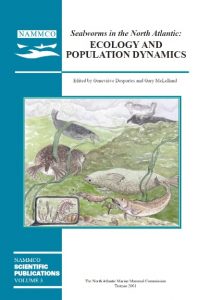Volume 3: Sealworms in the North Atlantic
 Sealworms in the North Atlantic: ecology and population dynamics
Sealworms in the North Atlantic: ecology and population dynamics
Sealworm (Pseudoterranova decipiens species complex), formerly known as codworm, are parasitic nematodes found in the flesh of Atlantic cod (Gadus morhua) and other fish species of commercial importance in the North Atlantic. Detection and removal of these parasites results in production delays and degradation of products, and is costly for the fish processing industry. Various approaches, including the culling of seals, have been proposed to reduce infection parameters in groundfish. A grey seal (Halichoerus grypus) cull conducted in Canada, from the 1960s to the early 1980s, seemed to stabilise both the seal population, and sealworm abundance in cod in the Gulf of St. Lawrence, but seal culls have not produced the desired results in Iceland.
Sealworm have a complex life cycle, involving benthic meio- and macro- invertebrates, small benthophagous fish and larger piscivorous fish as intermediate hosts. The final hosts are seals, and grey and harbour (Phoca vitulina) seals appear to be the most important seal hosts in the North Atlantic. Larval sealworm are also transmitted to piscivorous cetaceans, but seldom, if ever, survive to maturity in these latter hosts. Although the parasites reach maturity and reproduce in seals, the influence of seal abundance on abundance of larval sealworm in fish may be mitigated by a variety of other factors. Hence, changes in seal abundance may not lead to corresponding changes in sealworm infection parameters in fish. In confined areas, heavy infections in groundfish may be maintained by a few seals. While infection parameters in many eastern Canadian groundfish stocks have increased with the growth of the grey seal population, a decline in the grey seal population has not resulted in lighter sealworm infections in Icelandic fish. Similarly, decreases in sealworm parameters were not apparent in fish from the Norwegian inshore after the 1988 harbour seal epizootic.
Since the 1980s, modest efforts have been made to understand the population dynamics of sealworm in its intermediate and definitive hosts, and to develop methods of controlling the problem. A two-part workshop on the population biology of sealworm (Bowen 1990) was held in Halifax Nova Scotia in 1987 and 1988. This workshop brought together current information on the biology of the sealworm and of its intermediate and definitive hosts in an attempt to better understand the complex interactions which influence the abundance of the parasite in the marine environment. The working group concluded that:
- there was a lack of time series on trends in the abundance of sealworm in fish and seal hosts, on host population trends, and on inter-annual, geographic and seasonal variation in the diet of seals;
- little was known about the transmission rates of sealworm through invertebrate and fish hosts or about the dynamics of the parasite in the gut of seals. These uncertainties made it impossible to discriminate between alternative hypotheses about the relative importance of various abiotic and biotic factors in determining sealworm numbers;
- available data were insufficient to define models of sealworm population dynamics that would be appropriate to address management issues arising from the presence of sealworm in commercial fish species.
Following this workshop, and in accordance with its recommendations, intensive studies were conducted on both sides of the North Atlantic. During the past decade, economic problems associated with sealworm infection have increased in Iceland, Norway and the U.K., but have been supplanted by concern over the collapse of groundfish stocks and closure of fisheries in Eastern Canada.
In March 1996 the Council of NAMMCO forwarded the following request to the Scientific Committee:
Aware that the population dynamics of the sealworm (Pseudoterranova decipiens) may be influenced by sea temperature, bathymetry, invertebrate and fish fauna, the Scientific Committee was requested to review the current state of knowledge with respect to sealworm infection and to consider the need for comparative studies in the western, central and eastern North Atlantic coastal areas, taking into account the priority topics recommended by the Scientific Committee and its ad hoc Working Group on grey seals.
A Working Group, established to address this request, convened in Tromsø from 10 to 14 March 1997, and was attended by scientific experts from Canada, the U.K., Iceland and Norway.
The Working Group reviewed progress made since the 1987-88 workshop and reached a consensus on how to develop a more comprehensive understanding of the sealworm problem. The NAMMCO report provides a thorough review of the ecology and population dynamics of sealworm. We therefore thought it was useful to include it in this volume as the basis for further studies. The Working Group report has, however, been edited only to the extent that, where possible, references in the report now refer to contributions to this volume.
Most of the articles appearing in this volume were originally presented as working papers at the Workshop. They have been reviewed anonymously by two to three referees. They are included here under five topics: Invertebrate hosts, Fish hosts, Fish and seal hosts, Seal hosts, and Modelling.
The working group emphasised the need for establishing models to quantify cause-effect relationships in the dynamics of sealworm, and to be able to assess the efficiency of potential control measures. Indeed, the working group agreed that “enough new information was available to make a substantial advance over previous modelling efforts”. Let us hope that this volume will encourage some of the concerned parties to convene for such a modelling exercise.
Reference
Bowen, W.D. (ed). 1990. Population biology of sealworm (Pseudoterranova decipiens) in relation to its intermediate and seal hosts. Can. Bull. Fish. Aquat. Sci. 222: 306pp.
This volume is edited by Geneviève Desportes, Research Scientist at the Fjord & Bælt Centre, Kerteminde, Denmark, and Gary McClelland, Research Scientist with the Department of Fisheries and Oceans in Moncton, New Brunswick, Canada


